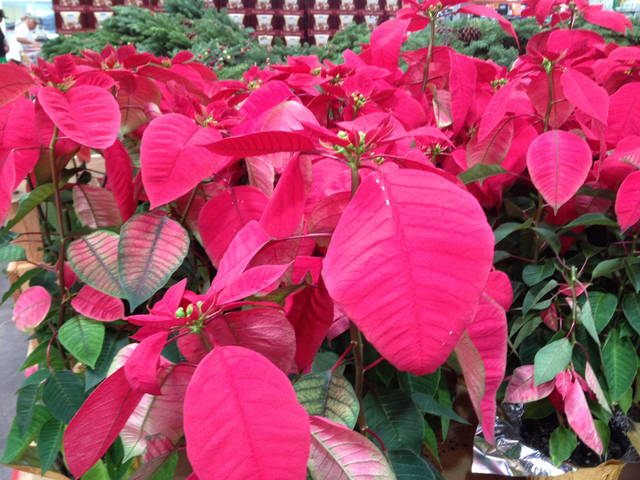Although we are well in to November, and we have been seeing Christmas decorations since Halloween, the Christmas holidays don’t seem real until we get our Thanksgiving meal digested. Poinsettias don’t seem to care since they are beginning to show color now. Folks on the mainland think of the poinsettia as a Christmas flower but for us it blooms now through March.
So if you don’t have a showy supply in your garden, now is the time to start looking for the first potted plants to show up in the marketplace. Most growers try to time flowering right after Thanksgiving, but in Hawaii it is a gamble. Temperatures and rainfall affect quality and timing.
Purchasing potted stock from a garden center or nursery is the easiest way to establish plantings of the holiday ornamental. However, some green thumb operators scavenge the neighborhood for hardwood cuttings when fellow gardeners prune their poinsettias following the flowering season. Getting plants this way can make you feel like a turkey if you choose cuttings from disease infected plants. If you get healthy plants, you can be sure to avoid fowl play — pun intended.
There are a number of poinsettias available. They come in traditional reds or you can enjoy color combinations indoors and in the garden if you mingle the red plantings with white and pink varieties. Since poinsettias give color from now through March, mixing plants in the garden will brighten things up for more than just the holiday season.
Poinsettias will grow on a wide range of soils, including sand, rocky soil and clay. They will not tolerate soggy or poorly drained soils. In spite of the wide adaptability, the plants will present you a better show of color if you take proper care of them.
In massed beds, fertilizer application is important. An application of fertilizer in August should now be producing large colorful bracts. The plants will need repeat applications of plant food in early spring, again in June and perhaps during mid-summer if there are heavy rains.
For best results, prune poinsettias back in late winter or early spring after blooming is over. Cut them back to within 12 to 18 inches of the ground.
You’ll find that a compact plant will furnish more color than a plant with few leggy stems. To promote a riot of colored bracts, prune the plants several times during the growing season. Nip the new growth back after it is 12 inches long, leaving four leaves on each shoot. Be sure to stop the pruning in early September, because the flowering buds are set in early October.
Poinsettias show their color according to the day length and temperature. A plant near a lighted window or a street light often refuses to color up like a neighboring plant in a nearby darker corner. Dreary skies in September and early October will shorten the days causing plants to set buds and flower before the holiday season.
You’ll find that temperature is a limiting factor for a good show of flowers. If the night temperatures are much above 70 degrees, bud forming will be retarded. Freak periods of hot weather during this critical time may not permit buds to form at all. The best flower development is when the night temperatures range from 60 to 68 degrees.
For plants in your garden, one problem to watch for now are mites. Drier conditions are ideal for this pest. Spraying with a miticide will take care of the little stinkers. If you want to avoid sprays, sprinkling the leaves daily with the garden hose is helpful. This will also minimize whitefly attacks. Avoid sprinkling in the heat of the day or late afternoon.
Poinsettias may be used as cut flowers if the stems are treated to coagulate the milky sap and reduce wilting. As soon as the flowers are cut, immerse the cut ends in hot water for about a minute, Then place them in cold water. Be sure that the steaming water does not damage the bracts.
An alternate method of halting the oozing sap is to singe the cut ends of the stem over a flame for a couple of seconds and then place the stems in cold water. For best results and longer lasting beauty, cut the poinsettias about 18 hours before they are to be used in an arrangement. Store the cut flowers in a cool, draft free place prior to use.
If you want to experiment with this year’s potted plant, don’t toss it out when the last leaf drops. The plant will show brilliant color next Christmas season if you follow these tips. First, store the pot, plant and all, in an out of the way place. This treatment is intended to hibernate the plant during the cool days while the shriveling top feeds the sleeping roots.
Only water the plant to keep it from getting bone dry. Avoid giving it fertilizer. Try storing the dormant plant in the shady corner of the carport.
Toward the end of February, tenderly awake the plant by cutting off the dead top. You can grow the new plant in last season’s pot, but the poinsettia will be happier if you set it in the ground where it can flex its roots better than in the confines of a pot. Make sure you plant it where it will get lots of sun and a well-drained soil.
Individuals with home garden questions may call the Master Gardener Helpline in Kona on Tuesday and Thursday from 9 a.m. to noon at 322-4893 or email at kona@ctahr.hawaii.edu. This is a free service provided by the University of Hawaii College of Tropical Agriculture and Human Resources.



